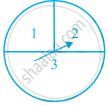Advertisements
Advertisements
प्रश्न
A card is drawn at random from a pack of 52 cards. Find the probability that card drawn is a red card
उत्तर
E⟶ event of getting a red card.
No. of favourable outcomes = 26 {13 hearts, 13 diamonds}
we know that, P(E) =`"No.of favorable outcomes"/"Total no.of possible outcomes"
P(E) =26/52 =1/2
APPEARS IN
संबंधित प्रश्न
The probability of an event that is certain to happen is ______. Such as event is called ______.
A lot consists of 144 ball pens of which 20 are defective and the others are good. Nuri will buy a pen if it is good, but will not buy if it is defective. The shopkeeper draws one pen at random and gives it to her. What is the probability that she will buy it?
A bag contains cards which are numbered from 2 to 90. A card is drawn at random from the bag. Find the probability that it bears a number which is a perfect square
In a class, there are 18 girls and 16 boys. The class teacher wants to choose one pupil for class monitor. What she does, she writes the name of each pupil on a card and puts them into a basket and mixes thoroughly. A child is asked to pick one card from the basket. What is the probability that the name written on the card is the name of a boy?
The faces of a red cube and a yellow cube are numbered from 1 to 6. Both cubes are rolled. What is the probability that the top face of each cube will have the same number?
Harpreet tosses two different coins simultaneously (say, one is of Re 1 and other of Rs 2). What is the probability that he gets at least one head?
A circle with diameter 20 cm is drawn somewhere on a rectangular piece of paper with length 40 cm and width 30 cm. This paper is kept horizontal on table top and a dice, very small in size, is dropped on the rectangular paper without seeing towards it. If the dice falls and lands on the paper only, find the probability that it will fall and land inside the circle.
A card is drawn from a pack of well - shuffled 52 playing cards . Find the probability that the card drawn is
(i) a diamond
A game consists of spinning an arrow which comes to rest pointing at one of the regions (1, 2 or 3) (figure). Are the outcomes 1, 2 and 3 equally likely to occur? Give reasons.
Following experiment have equally likely outcomes? Explain.
A trial is made to answer a true-false question. The answer is right or wrong.
